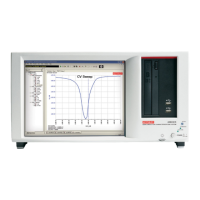4200-900-01 Rev. K / February 2017 Return to Section Topics 3-147
Model 4200-SCS User’s Manual Section 3: Common Device Characterization Tests
1. If system connections have not been made, follow the instruction in Running any Flash
Project for the first time.
2. Start KITE by double-clicking the KITE icon on the 4200-SCS desktop.
3. Open the appropriate KITE Flash project.
a. In KITE, click FILE > Open Project. If the dialog window is not displaying the _Memory
folder, move up one or two levels to the display the Projects directory. Double-click the
_Memory folder, then double-click the appropriate Flash test folder, then double-click
the appropriate *.kpr file to open the 4200-SCS Flash project. KITE should resemble
Figure 3-116.
4. Touch-down or connect the DUT.
5. Verify setup and connection by running Vt-MaxGm test
a. Set appropriate voltages
b. Run the test by clicking the yellow and green triangle Append button.
c. Ensure that the V
G
-I
D
and V
T
results are reasonable.
6. Determine the appropriate pulse voltage levels:
a. Review the section Pulse waveforms for NVM testing on page 3-109.
b. Recall that pulse voltage levels on the gate will double. For example, using
PulseVoltage = 2 will result in V
G
= 4 V for a typical high-impedance (1 k Ω) terminal.
c. Use oscilloscope to determine appropriate PulseVoltage values for the V
G
and V
D
,
making sure to use the 1 M
Ω input setting on the oscilloscope:
i. Drain: Connect the oscilloscope probe across the drain-source of the DUT.
ii. Use the Program and Erase UTMs to output pulses, while using the oscilloscope to
measure the pulse height. Iterate by modifying the PulseVoltages to reach the target
voltage.
7. Once the appropriate voltage level is determined, the appropriate pulse width may be
determined by iteratively outputting pulses while occasionally measuring the V
T
.
a. Start by using a pulse width that is shorter than the expected PW. For example, if 20 μs
is the expected PW, try using a 2 μs PW.
b. Enter the parameter values into the Program UTM, following the procedure in Running
the Program or Erase UTM. Initially, set NumPulses = 2, or another small number.
c. Uncheck the Erase and Fast-Program-Erase tests.
d. Enter the parameter values for the Vt-MaxGm test, following the procedure in Running
the Vt-MaxGm ITM.
e. Run the test:
i. Double-click 4Terminal-FloatingGate
ii. Click the Run button
iii. Check the graph on the Vt-MaxGm test. It will likely be too low on the first few runs, but
note the total number of pulses sent to the DUT.
iv. Rerun test by following the previous Run the Test steps. Once the V
T
has met the target
value, note the total pulse width to use to program the device, using either the Program
or Fast-Program-Erase tests.
f. Repeat above with the Erase test, feeding final results into the Erase and Fast-
Program-Erase tests.
g. Ensure that the erase parameters are fully erasing the DUT
i. Set the parameters in the Fast-Program-Erase test. Set NumPulses = 10.
ii. Uncheck the Program and Erase tests.
iii. Double-click 4Terminal-FloatingGate. Press run.
iv. Note the V
T
.
v. Change NumPulses = 100 or a larger number.
vi. Double-click 4Terminal-FloatingGate. Press Append.
vii. Note the V
T
. If the V
T
value for the tests are similar, then the erase pulse is fully erasing
the DUT.

